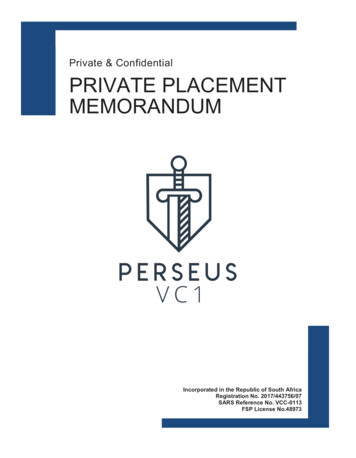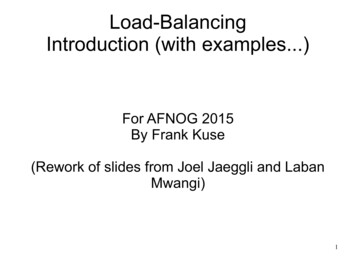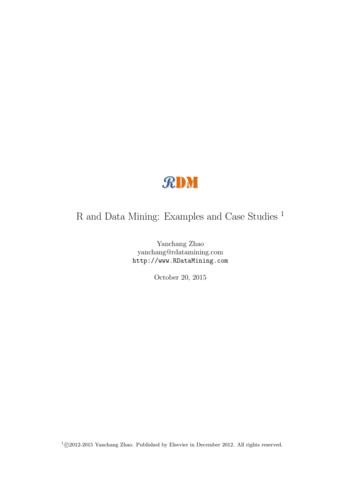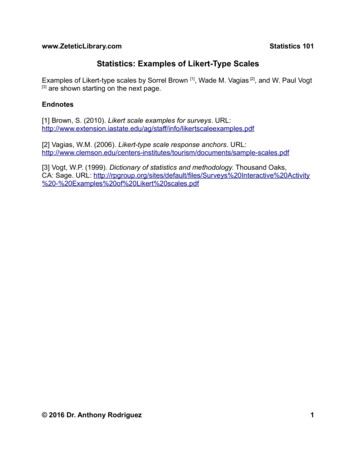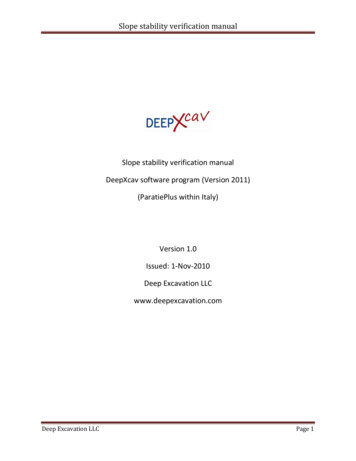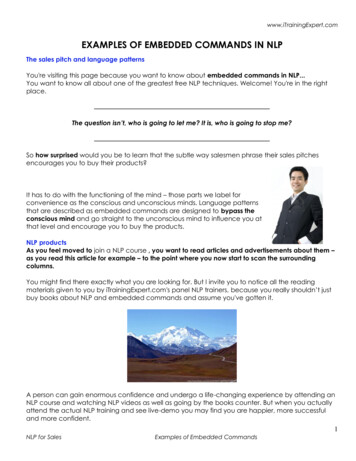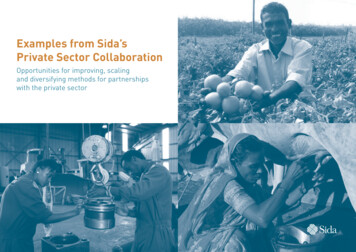
Transcription
Examples from Sida’sPrivate Sector CollaborationOpportunities for improving, scalingand diversifying methods for partnershipswith the private sector
Table of contentForeword1Improving sustainable smallholder farming in Bangladesh2Invigorating business environments in Bosnia-Herzegovina4Improving Industrial Relations in Cambodia6Innovations for peace in Colombia8Creating job opportunities in Ethiopia10Tackling Energy Poverty in Kenya12Inclusive Growth through Decent Work in the Great Rift Valley14Reducing youth unemployment in Kenya16Beyond the Grid Fund in Zambia18Innovation Against Poverty Challenge Funds20Securing Water for Food: A Grand Challenge for Development22Strengthening the private sector in Somalia24Private Sector Networks – examples26Examples of local networks27Case index28
Dear partners and colleaguesTo achieve the Sustainable Development Goals (SDG), allactors in society must collaborate and contribute. The privatesector can support development and reduce poverty as theyimprove productivity, economic growth and the creation ofdecent jobs. Private actors can bring new perspectives, ideasand solutions, different to that of traditional developmentactors.Development agencies play an important role in engagingthe private sector in broader development efforts, especiallywhen it comes to the first SDG: No Poverty. By partneringwith the private sector, development cooperation can leverageactions and achieve results that would not have otherwisebeen possible.Sida’s private sector collaboration focused initially on afew specific instruments and methods such as funds andguarantees. Today, collaboration with the private sector hasevolved towards a more systemic approach, encouragingprivate sector collaborations at the implementation level,building competence and establishing business networkssuch as Swedish Leadership for Sustainable Developmentto better understand the private sector’s potential role in1development cooperation. This has led to innovative projectswhere instruments have been combined in new ways orcompletely new instruments have been developed.This collection of examples is an excerpt from an internalstudy, Sida’s Private Sector Collaboration: Opportunities forimproving, scaling and diversifying methods for partnershipswith the private sector. The study looks at 16 strategies at theglobal, regional and bilateral level to see when, why and howSida collaborates with the private sector.*The examples aim to be a source of insight and inspirationfor engaging with the private sector and achieving betterdevelopment results.Happy reading!Maria Stridsman,Deputy Director, Department for Partnership and Innovation, Sida* The 16 strategies are: Bangladesh, Bosnia, Cambodia, Colombia, Ethiopia, Guatemala, Kenya,Palestine, Serbia, Somalia, Ukraine, Zambia, Regional Africa, Regional Asia, and two globalstrategies for sustainable economic and environmental development.
Improving sustainable smallholder farming in BangladeshAbout the project Project: Dairy Hub and Dairy Academy Development Project Partnership Tool: Public-Private Development Partnership Partners: Sida, United Nations Industrial DevelopmentOrganization (UNIDO), Tetra Pak, PRAN Ltd., Ministry of Fisheriesand Livestock’s Department of Livestock Services, smallholderdairy farmersBangladesh is among the world’s most densely populated countries,with around 165 million people living in the delta of the Ganges andthe Brahmaputra. The country faces great challenges related tomalnutrition and undernutrition.The dairy and beef sub-sectors in Bangladesh are characterizedby small-scale producers. Most dairy farmers in Bangladesh aretraditional smallholder farmers with little or no access to education,technical services or the commercial market. Yields are low,and loose milk is sold directly to consumers at markets, with noguarantee of quality or hygiene.2 Development Objectives: To improve the livelihood of small dairyfarmers in Bangladesh through increased quality and yield of milk,allowing the replacement of imported powdered milk. Duration: 2013-2019 Budget: 63 000 000 SEK (Sida 21 000 000 SEK and PRANapproximately 42 000 000 SEK) Thematic area: Agriculture
Improving sustainable smallholder farming in BangladeshIn 2013, Bangladesh’s second largest dairy processer, PRAN Dairy.approached Sida with a project proposal in collaboration with theUnited Nations Industrial Development Organization (UNIDO) andthe multinational food packaging company Tetra Pak.PRAN and Tetra Pak had jointly developed a new innovative modelfor integrating dairy smallholder farmers in the formal supply chainof the commercial market. The project proposal to Sida covered anexpansion of the activities to other districts and villages, with thegoal to improve living conditions for 10 000 farmers. Sida and PRANfunded the project and UNIDO served as the implementing partner.The project set up local milk collection centres, where the milkcould be properly collected, tested and cooled. In addition to highquality cooling facilities and infrastructure, the Dairy Hub providestraining and a demonstration farm to support PRAN’s educationalproject, the Dairy Academy, in sharing best practices and increasingcompetence in the field.The strategic objective was to improve the livelihood of small dairyfarmers in Bangladesh trough increased quality and yield of milk,allowing the replacement of imported powdered milk. In this case,the demand for locally produced milk already existed, while themodel for collaboration was tested. A key success factor in thisproject was the market-driven approach.3ResultsAfter 44 months of operation, results have shown that: The milk yield per cow has increased by 118% The quality of the locally produced milk has improved The average income for the farmers has increased by 137% There has been a ten-fold increase in the number of farmersmoving from producing milk for family consumption to commercialmilk production as a source of income
Invigorating business environments in Bosnia-HerzegovinaEver since the end of the Bosnian war in 1995, Bosnia-Herzegovinastruggles with a complicated political system and economicchallenges. The private sector is small, access to risk-sharingcapital is limited, and it is difficult for young entrepreneurs todevelop their business ideas. There is a lack of skilled labour, and asubstantial number of young people leave the country every year tosearch for jobs in EU countries.In 2013, a small pilot fund, The Challenge Fund, was launchedwith a budget of SEK 5 million as part of Sweden’s developmentcooperation portfolio in Bosnia-Herzegovina. The main objective wasto strengthen economic development and cooperation betweenSweden and Bosnia-Herzegovina. Companies and entrepreneurswere invited to apply and compete for grants to finance theirinnovations and business ideas. Grants were capped at EUR 30 000and successful applicants had to match the grant with 50 percentof their own capital. The proposals needed to include potentialemployment effects, with a premium for employment of youth andwomen. The target group was micro and small enterprises as well asstart-ups in Bosnia-Herzegovina, but also Swedish-based companieslooking to do business in Bosnia-Herzegovina.The pilot fund held three calls for proposals and received1148 applications. In the end, 27 companies were awarded grants.4About the project Project: The Challenge fund project Partnership tools: Challenge fund Partners: Sida, awarded companies Development objectives:To stimulate new enterprises and innovation in Bosnia-Herzegovinaand a technology transfer to Bosnia-Herzegovina.To support the private sector in Bosnia-Herzegovina by providinggrants to project proposals that deliver both commercial benefitsfor the private sector and development benefits for the people ofBosnia-Herzegovina. Duration: Pilot The Challenge: 2013-2015 Budget: Pilot The Challenge: SEK 5 000 000(of which SEK 4 500 000 for grants) Thematic area: Employment
Invigorating business environments in Bosnia-HerzegovinaAlmost half of these companies were small enterprises with threeemployees or fewer, and 40 percent were start-ups. Most of themcame from the IT sector. The pilot fund was implemented by theSarajevo Economic Region Development Agency (SERDA) and theRepublic Agency for Development Small and Medium Enterprise(RARS). An additional project partner was the Region Ostergotlandfrom Sweden.Thanks to the experiences from the first pilot fund, Sida was ableto launch a second more extensive fund in 2017. The new fundwas called Challenge to Change and received a budget of SEK40 million. The structure was similar to the pilot fund but wasimplemented by an external partner with the aim to increaseemployment and women’s economic participation, and tocontribute to general economic growth.5ResultsThe Challenge funds have: Stimulated engagement and expansion of small enterprisesthrough fairly small financial incentives. The cost sharing, with 50percent funding from awarded enterprises, ensured sustainabilityand continuous commitment from private sector partners. Helped young entrepreneurs to stay in Bosnia-Herzegovinato develop their businesses instead of leaving the country. Theyhave provided unique opportunities in early phases of businessdevelopment when external funding is often difficult to secure. Provided opportunities for companies to implement innovativeand commercially sustainable ventures, and to stimulate technologytransfer from Sweden.
Improving Industrial Relations in CambodiaThe garment sector in Cambodia is the largest manufacturingindustry and the biggest employer in the country. It alreadyaccounts for 80 percent of Cambodia’s export earnings andemploys around 700 000 people in a country of 16 million people.The female-dominated industry provides an important source ofincome for women, and has been an incubator for the developmentof the country’s trade unions.The manufacturing industries in Cambodia are characterized byunfair labour practices and face many challenges concerninglabour rights and decent working conditions. Insufficientmechanisms for peaceful labour market dispute resolution has ledto violent conflicts between workers and employers.In 2014, a new partnership to promote sound industry relationsand decent work in the garment sector was launched by theEmbassy of Sweden in Phnom Penh, the International LabourOrganization (ILO), the Swedish labour union IF Metall and theSwedish fashion chain H&M Group. The project aimed to promotesound industrial relations through collective bargaining, as wellas to strengthen the regulatory and policy framework governingindustrial relations. Policy was combined with capacity building toprovide training that helped stakeholders implement more soundand appropriate policy approaches.6About the project: Project: Improving Industrial Relations in Cambodia’s GarmentIndustry Partnership tools: Public Private Development Partnership Partners: Sida, ILO, H&M Group, IF Metall Development objectives: Promoting sound industrial relationsthrough collective bargaining and strengthening the regulatory andpolicy frameworks. Duration: 2014-2017 Budget: USD 773 505 Thematic area: Human Rights, Labour Rights
Improving Industrial Relations in CambodiaAt the enterprise level, this included training in workplacecooperation, labour law, social dialogue, gender,non-discrimination. It also encouraged agreementsbetween employees and employers.The project was led by the ILO and jointly funded by Sida and theH&M Group. It had an overall budget of USD 773,505 plus in-kindcontributions provided by IF Metall.Results:Project results included: In total, 26 factories participated in the project. Theysigned an agreement to engage in collective bargaining andto refrain from unfair labour practices. The project created dialogue between the government,major union confederations, and the industry associationGarment Manufacturers in Cambodia. Interventions at thenational level included training for the Ministry of Labourand vocational training in policy development. The project reached local factories that otherwise couldhave been difficult to influence.7
Innovations for Peace in ColombiaColombia is Latin America’s fourth-largest economy and is richin natural resources. However, the country’s development ishampered by challenges such as weak institutions, unsustainableuse of natural resources and armed conflicts driven by guerrillasand paramilitary groups. The people of Colombia have sufferedviolence and armed conflicts since the early 1960s. In 2016, ahistoric peace agreement was signed between the governmentand the country’s largest guerrilla groups, officially bringing thelongest-lasting conflict in the Americas to an end.That same year, Sida launched a new Challenge fund, Innovationfor Peace-II in Colombia, based on a previous challenge fund from2012. The aim was to support economic development in conflictaffected areas. Colombian entrepreneurs were encouragedto apply for grants to launch business innovations linked topeace building. Increasing access to finance, building capacity,supporting business ideas and developing market linkages werecrucial to ensure the sustainability of the initiatives.The Challenge fund was implemented by the non-profit platformReconciliación Colombia, an alliance of more than 30 civil societyorganizations. Through a robust selection process, 10 initiativesreceived funding in the first year. The finalists pitched to a jury, andregional visits were made to collect baseline data and to verify theapplications.8About the project Project: Innovation for Peace (I and II) in Colombia Partnership tools: Challenge fund accompanied by a guarantee Partners: Sida, USAID, ECOPETROL, Reconciliación Colombia Development objective: To improve the economic situation forwomen and men affected by conflict or living in conflict-affectedregions by building capacity, increasing access to finance, supportingbusiness models and developing market linkages Duration: 2016-2019 Budget: SEK 13 000 000 Thematic area: Civilian peacebuilding, conflict prevention andresolution, private sector development
Innovations for Peace in ColombiaAll accepted initiatives received tailor-made technical assistancefor two years which could include setting up financial systems foraccounting, obtaining equipment or receiving legal advice.The fund was scaled up in the second year thanks to two newdonors joining the initiative – USAID and the Colombian oilcompany, ECOPETROL. In the second call, 17 new entrepreneurswere awarded grants for their business ideas.ResultsThe funds have led to: 27 companies have received funding, mainly agribusinessesin rural areas. By February 2019, 2 000 families had been helped by theinnovative businesses, and 25 of the initiatives have shownsignificant improvements in production, sales and income forparticipating men and women. An initiative headed by 14 women selling ornamental fishincreased production by 271% and sales by 15% thanks to theSwedish contribution and their own co-investment. Other innovations that were awarded grants include processingtechnology for ice cream production and improved cocoa productiontechniques.9
Creating job opportunities in EthiopiaWith around 102 million people, Ethiopia has the second largestpopulation in Africa. Despite many years of strong economicgrowth, the country is still one of the world’s poorest withextensive inequalities and high unemployment rates, especiallyamong youth. A large part of the workforce – around 35 millionpeople – lack education and are employed in low-skilled jobs.In 2011, a Public Private Development Partnership (PPDP) waslaunched with Sida, UNIDO and Volvo that aimed to address theprivate sector’s need for skilled workforce and the country’s highunemployment rate. Volvo had received a large order of 800 trucksfor a transport investment project in central Ethiopia and neededhighly-trained mechanics to secure sustainable maintenanceof the trucks. This resulted in Ethiopia’s first state-of-the-artvocational training for heavy machinery being established at theSelam Technical and Vocational College in 2012-2019. A project fortraining of drivers has since also started.In this public-private development partnership, the new jobopportunities were directly connected to actual needs in the labourmarket. Furthermore, conventional classroom teaching wascombined with practical training methods.10About the project: Project: Heavy Duty Equipment and Commercial Vehicles Academy Partnership tools: Public Private Development Partnership Partners: Sida, UNIDO, Volvo, Selam Technical and VocationalCollege, Ministry of Education and Ministry of Industry Development objectives: Providing underprivileged youthwith skills, help strengthen vocational training, engage a majormultinational company in active provision of human resourcedevelopment outside its own organisation, creating employmentopportunities for young Ethiopians as commercial vehicle drivers. Duration: 2012-2019 (Mechanic program), 2017–2021 (Driverprogramme) Budget: USD 5 271 914 (Mechanic program), SEK 28 500 000 (Driverprogramme) Thematic area: Youth Employment
Creating job opportunities in EthiopiaBy creating a platform for dialogue and collaboration, the strengthsof the different partners were combined when designing the trainingprogramme.Sida played a significant role in facilitating the set-up of thepartnership. Volvo contributed with technical equipment, trainingmaterial, training of teachers, ongoing curriculum developmentand apprenticeship opportunities for students.UNIDO was responsiblefor the overall projectmanagement and addedconsiderable experience withtechnical vocational training.Selam Vocational TrainingCollege, where the trainingtook place, managesthe administration ofthe academy, teacherrecruitment and studentselection.11ResultsThe results of the project have shown: Provided students with training in modern machinery operation,English and IT. Trained 25-40 heavy-duty mechanics students per year and hasbeen open to applicants regardless of background In total, 215 students have graduated from the Heavy DutyEquipment and Commercial Vehicles Academy (HDECoVA), and atleast 91 per cent of the graduates have found employment. In 2015, the Academy was selected as one of 10 winners ofthe competition “TVET for the 21st Century in Africa: The MostPromising Practices on the African Continent”. In 2018, a new project ”Misale Academy” was launched to trainyoung Ethiopians in commercial vehicle driving and was based onthe experience and lessons learnt from the mechanics trainingprogramme.
Tackling Energy Poverty in KenyaThe Government of Kenya has stated in its development blueprintthat all Kenyans should have access to quality energy by 2030.However, challenges remain in devising a system to identify thepoorest in need of affordable energy access. A large proportion ofthe Kenyan population lack access to electricity because they arelocated far from the national grid.In 2017, the Embassy of Sweden in Nairobi initiated discussionswith renewable energy providers, UNICEF, the Ministry of Labourand Social Protection and consultants from the US Power Africateam in order to ensure access to affordable quality energy. Theaim was to investigate if it was possible to leverage the socialprotection system to provide energy access to the poorestsegments of society. The same year, the partners launched a pilotprogramme, Energy for the Poorest, based on finding a solutionto the existing need of electricity by using an already existingframework – Kenya’s social cash-transfer system.The cash-transfer system was implemented in 2004 by theMinistry of Labour and Social Protection. The system has a robustdatabase and targets the poorest million in the country, whereeach targeted family is attached to a social worker that supportsthem in their efforts to improve their lives.12About the project Project: Energy for the poorest Partnership Tool: An innovative approach to combine existingpublic sector systems with private sector collaboration. Partners: UNICEF, Ministry of Energy and Ministry of Labour andSocial Protection, county governments, payment service providersincluding local banks, private solar companies Development Objectives: The project aims to enhance access toenergy for the most vulnerable segment of the poorest and increasepenetration to households in the bottom of the pyramid. Duration: Pilot Programme 2017-2020 Budget: USD 838 222 97 Thematic area: Energy, health and education
Tackling Energy Poverty in KenyaThe families are also part of a Beneficiary Welfare Committee.Transfers are made through normal bank channels, involving bothcentral and local levels.The collaboration represents an interesting example of innovationconsisting of linking and leveraging already on-going initiatives indifferent sectors with each other - the energy and social sector.The programme is using the same channels, actors and databaseas in the social cash-transfer system and is now being rolled outand tested.ResultsResults from the programme have shown progress in: Keeping children in school Reducing child labour Strengthening the overall legal status of poor families The companies view the poorest families as potential futurecustomers of a new market that previously has been too remoteand too risky to enter In November 2018, 1500 targeted households accessed solarhome systems and solar lanterns13
Inclusive Growth through Decent Work in the Great Rift ValleyThe provision of reliable and affordable electric energy isindispensable for social and economic development. In Kenya,there is great potential for geothermal energy to generate morepower capacity to the national grid and to promote economicgrowth. Akiira Geothermal Limited, an electric energy generatingcompany, operates as a geothermal exploration and power plantdevelopment project and is planning a major investment by settingup a geothermal power plant in Kenya’s south Rift Valley.About the project: Project: Inclusive Growth through Decent Work in the Great Rift Valley Partnership tools: Public Private Development Partnership; Guarantee Key partners: Sida, ILO, Forum Syd, Akiira Geothermal Ltd, KenGenLtd, Olserian Ltd and other private sector partners, Ministry of Education,Science and Technology, Ministry of Energy, Ministry of Labour and SocialProtection, civil society organizations, local communities, academia,tripartite partners of ILO and unions Development Objective: Poverty reduction and improved living conditionsthrough decent work and access to rights-based services among the ruralpopulation in the Great Rift Valley in Kenya Duration: May 2018–May 2022 Budget: USD 4 870 000 (63%) in Sida funding and USD 2 890 000 (37%)in mobilized capital, aiming towards a 50/50% shared funding betweenSida and other stakeholders by the end of program period Thematic area: Market Development, Employment, Human Rights,Renewable Energy14
Inclusive Growth through Decent Work in the Great Rift ValleyIn 2015, a dialogue was initiated when Akiira approached Sida todiscuss a guarantee for a bank loan. The partnership took formbased on Akiira’s commitment to make a positive impact on thelocal communities and the demand for local workforce.In 2018, a Public Private Development Partnership was signed,with the objective to reduce poverty and improve living conditionsthrough decent work and access to basic services among the ruralpopulation in Great Rift Valley. The partnership is co-implementedby ILO and Forum Syd. ILO is responsible for skills developmentand job creation, and Forum Syd develops capacity of the localcommunities to advocate for their rights and access basic services.The private sector is contributing with knowledge, resources,market absorption and employment opportunities; which ensuresownership, sustainability and opportunities to scale up.This multi-stakeholder partnership is an example of how oneprogram can address several areas in the development cooperationstrategy – such as employment and decent working conditions;improved gender equality; democratic governance; as well asincreased production of renewable energy.Today, more than 20 partners – county government, centralgovernment, civil society organisations, local communities,academia and public and private technical and vocational educationand training institutions (TVET) - are involved in the partnership.15Project goal Poverty reduction and improved living conditions throughdecent work and access to rights-based services among the ruralpopulation in the Great Rift ValleyObjectives To create decent jobs from better skills by vocational trainingcentres To develop new and improve growing businesses resulting fromnew relevant skills, business development services and access tofinance To increase the capacity of communities to lobby for increasedaccess to public and social services e.g. water, education, health,sanitation and counties are better able to provide the basic services
Reducing youth unemployment in KenyaKenya has a very young population, almost three-quarters areunder the age of 30. It is estimated that around one million youthare unemployed with limited opportunities to enter the labourmarket. There is a mismatch between the extensive number ofunemployed youths globally and employers’ need for workforcearound the world.As a response to this situation, the global non-profit organisationGeneration launched a global youth employment program in 2014.The program aims to empower young people to build sustainablecareers and at the same time provide employers with the skilledlabour they need. The target group is youth between the age of18 and 30, from underprivileged urban and semi-urban areas,living in poverty.About the project Project: Generation Kenya Partnership Tool: Large-scale multi-stakeholder hybrid Public PrivateDevelopment Partnership Partners: Sida, Generation Global and Generation Kenya, privatesector (over 350 companies), the private and public TVET system, countygovernment, central government and the youth. Development Objectives: To scale up the program to reach 45 000marginalized youth, to work for systemic change, influence, capacitateand strengthen the public TVET system, incorporate decent work andgender equality aspects into the program and make it 60% selfsustainable by the end of 2023. Duration: 2018-2023 Budget: USD 4 500 000 representing 22% of the total budget. Rest isfrom private sector, public sector, TVET institutions, students and otherdevelopment partners. Thematic area: Employment16
Reducing youth unemployment in KenyaIn 2015, Generation Kenya was initiated as a public privatepartnership, in collaboration with the private sector; Technical andVocational Education and Training (TVET) institutions; central andcounty governments; and the youth. Two years later, GenerationKenya approached the Embassy of Sweden, with a request forfinancial support from Sida. After assessing the first programme,Sida signed a partnership agreement in 2018 with a donation ofUSD 4.5 million (representing 22 percent of the total budget) forfive years, expanding its reach, to over 45 000 marginalised youth.The programme is based on an education-to-employment model,in which the employers are included in the entire programmedesign process and take on a significant ownership role. Thetraining consists of boot camps, where the students are providedinteractive training to gain technical skill. Coaching, résumébuilding, interview rehearsal and ongoing support is providedduring and beyond the programme period. After the completedtraining, the students are directly called to job interviews.Today, the programme is active in five sectors - financial servicessales, distributed sales, retail, restaurant, customer serviceagents and sewing machine operators - in cooperation with350 private sector employers.17ResultsResults from the programme have shown: Since 2015, 84% of the 13 000 graduates were immediatelyemployed through the network of more than 350 employers. 57% of Generation Kenya graduates were women. The programme had a positive impact on average income,with estimated increase of 370% The programme shows a measurable return on investment for theemployers by lowering costs for recruitment and obtaining trainedemployees in line with their needs. Generation recruits performbetter, are more dedicated and have higher retention rates thannon-Generation recruits.
Beyond the Grid Fund in ZambiaZambia is often characterized as a peaceful country with a decenttrack-record of democratic transitions and continuous economicgrowth. Despite economic development, the gap betweenurban and rural population is vast. Over 75 percent of the ruralpopulation lives in poverty and more than 90 percent lack accessto electricity.Sustainable energy systems are important for mobilizing externalcapital and investments in private sector collaboration. Offgrid energy solutions are often the quickest path for the mostvulnerable and remote communities to obtain increased access toelectricity.Since 2015, Sweden has participated in the Power Africa initiative,which mobilizes private investments for electricity access in subSaharan Africa. The aim is to reach USD 1 billion over 10 yearswith innovative financing methods. In March 2016, the Embassy ofSweden in Zambia launched Power Africa: Beyond the Grid FundZambia (BGFZ) to bring off-grid energy to unprecedented scale.The programme applies a results-based financing and risksharing approach called Social Impact Procurement, in whichgrant funding essentially is used to “buy” access to electricitydirectly from private service providers for a predefined number ofpeople, using pro-poor business models.18About the project: Project: Beyon
The private sector is small, access to risk-sharing capital is limited, and it is difficult for young entrepreneurs to develop their business ideas. There is a lack of skilled labour, and a substantial number of young people leave the country every year to search for jobs in EU countries. In 2013, a
